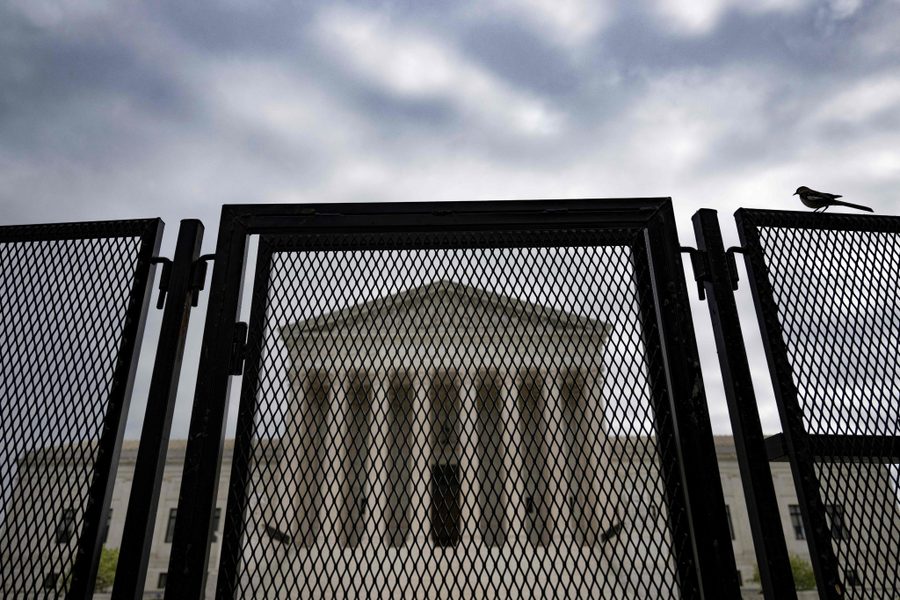The Supreme Court Is Gutting the Regulatory State. Let's Look at Our Other Options.
It’s time to talk about public ownership.
Thomas M. Hanna

At the end of June, the conservative-dominated U.S. Supreme Court issued an explosive series of politically and ideologically motivated decisions designed to fundamentally reshape society. Over the course of just a few days, the Court struck down federal abortion rights, trampled on indigenous people’s rights, further eroded the separation between church and state, aided the proliferation of gun violence, and kneecapped the federal government’s ability to address climate change.
While shocking, these rulings are not surprising. In fact, they are part of a decades-long, highly successful war by the political Right to dismantle the mild regulatory and social democratic state that developed following the New Deal and World War II, and revive and reinvigorate private, elite (i.e. wealthy and white) control of society and the economy. While such efforts must be resisted, and the war is far from over, progressives can no longer avoid the fact that the contemporary model of regulating private enterprise and blunting the worst excesses of capitalism is failing — failing not because people aren’t voting the right way or because of changes in how we communicate, but failing because of its own structural limitations.
Given the existential threat of catastrophic climate change, and the rising tide of right-wing extremism, a different approach is needed, and needed soon. One alternative is to shift away from the strategy of trying to regulate for-profit corporations and tax large concentrations of privately owned wealth, and instead move toward a system based on principles of genuine economic and political democracy, and comprised of various forms of public and collective ownership.
Whither Social Democracy?
Social democracy was initially founded on the idea that society could transition from capitalism to socialism peacefully via democratic political institutions. But in its modern incarnation, the term more often refers to a political and economic system based on the idea that the excesses and injustices of capitalism can be ameliorated primarily through state regulation of private enterprise, rather than large-order shifts in the ownership of those enterprises. As the German revisionist Marxist Eduard Bernstein, often considered the father of social democracy, once put it, socialization “can also take place if the general public intervenes ever more strongly in support of economic life through laws and ordinances,” via, for instance, minimum-wage legislation, occupational safety standards, price controls and other regulations. This regulatory approach is, then, usually combined with both a strong social safety net supported by tax-and-spend policies and the extension of political and social rights to traditionally marginalized groups.
Following World War II, social democrats (in either name or deed) came to power in many countries around the world, especially those in Europe that had been economically and socially devastated by the war. With the economic and business elite in many of those countries temporarily discredited by their associations and infatuations with fascism, some of these countries were able to build strong welfare states characterized by empowered trade unions, reductions in economic inequality, and marked improvements in health and living standards. In the United States, a weaker version of social democracy took hold through the federal government’s robust response to the Great Depression (the New Deal) and the centralizing forces of war mobilization.
While some significant ownership shifts did occur, especially in the early days of the New Deal, the U.S. variant of social democracy was always primarily regulatory in nature, with famous examples being financial laws such as the Glass-Steagall Act (which limited the activities of private banks), environmental laws (which restrict pollution and extraction), food, drug and medical device quality laws, labor laws, and so on. Moreover, actual implementation and enforcement of these laws was often delegated to regulatory agencies, such as the Food and Drug Administration and the Environmental Protection Agency, giving rise to the term the “regulatory state.” Like in Europe, this approach initially found some success. By the late-1970s, income and wealth inequality had hit historic lows, poverty was falling, rivers and the air were being cleaned up, labor unions were still comparatively strong, living standards had risen, and life expectancy had improved dramatically.
However, since its inception, business elites and their political allies have chafed against this regulatory approach to moderating capitalism (while, paradoxically, often using it to their own material benefit). Commenting on the opposition he faced, Franklin D. Roosevelt (FDR) once famously stated “we had to struggle with the old enemies of peace — business and financial monopoly, speculation, reckless banking, class antagonism, sectionalism, war profiteering… Never before in all our history have these forces been so united against one candidate as they stand today. They are unanimous in their hate for me — and I welcome their hatred.” Like today, these business interests attempted to thwart the implementation of FDR’s social democratic programs through the Supreme Court — but, ultimately, he was able to face them down through, for instance, threatening to “pack” the Court.
However, the real counterattack against the regulatory state began in the late 1960s and early 1970s. Capitalizing on the social and economic upheavals of the time, the business community and economic elite, along with their “free market” allies in academia, sprang into action. In 1971, just a few months before he was nominated to serve on the Supreme Court, Lewis F. Powell Jr. — a corporate lawyer who sat on the board of the tobacco company Philip Morris — wrote a letter to the U.S. Chamber of Commerce castigating the business community for its supposed inattention to (and complicity in) the “attack on the American free enterprise system.”
The business elite responded, and soon vast sums of money began flowing to an array of new and existing right-wing organizations — including the American Enterprise Institute (founded in 1938), the Reason Foundation (founded 1968), the Heritage Foundation (founded in 1973), the Cato Institute (founded in 1977), the Manhattan Institute (founded in 1977), the American Legislative Exchange Council (ALEC; founded in 1973), and the Federalist Society (founded 1982). The effort was so successful that by Ronald Reagan’s first term, these organizations provided more than half of his high-level presidential appointments.
Under the influence and direction of these organizations and their acolytes, deregulation of the U.S. economy kicked into high gear, championed by both Republicans and Democrats alike. This includes high-profile legislation like, for instance, the 1999 law which essentially repealed the Glass-Steagall Act. However, more insidiously, it also includes a full-blown assault on the agencies tasked with implementing and monitoring regulatory rules. Regulatory agencies are regularly swamped with industry lawsuits and lobbying, vilified by corporate-funded propaganda campaigns, purposefully saddled with leaders who are hostile to their mission (e.g. Rick Perry’s being appointed Secretary of Energy in 2017, an agency he called to be eliminated a few years earlier), sapped of talent by the private sector and, most recently, undercut by the Supreme Court.
In the recent case of West Virginia v. Environmental Protection Agency (EPA), the Supreme Court’s six conservative judges (all of whom are members of the Federalist Society) ruled that the regulatory agency had overstepped its authority by promulgating the Clean Power Plan rule — which had the goal of reducing carbon emissions by requiring utilities to invest in efficiency measures and shift generation from high-emitting to low emitting sources. By both action and deed, the EPA case demonstrates the Supreme Court’s intent to dismantle as much of the remaining regulatory apparatus as possible. First and foremost, that the Court took up the case was highly unusual given that the Clean Power Plan had been scrapped by President Trump and was never formally implemented. Second, for the first time, the Court’s majority specifically invoked the “Major Questions Doctrine,” which is a relatively novel and deeply ambiguous judicially created concept (in other words, created by the Court) that allows the Supreme Court to intervene and strike down a regulatory agency’s action if it “concerns an issue of vast economic and political significance.” And third, the ruling — specifically, Justice Neil Gorsuch’s concurring opinion — explicitly takes aim at “the explosive growth of the administrative state.”
President Biden has signaled interest in using executive powers wherever possible — for instance, on abortion access and climate change — and the Democratic Party leadership in Congress has attempted to pass new laws that would reverse or mitigate some of the Court’s rulings. But these efforts are essentially a rear-guard action that ignores an important reality about the social democratic, regulatory model: namely, that the approach is structurally limited in what it can achieve. By leaving powerful for-profit corporations intact and large pools of capital in elite, private hands, social democracy as currently practiced all but guarantees that even the strongest regulations and laws will eventually be eroded, undermined, captured and manipulated by these economically powerful entities and individuals.
Because of this reality, the social democratic model is in retreat around the world, including in its European heartlands. In Sweden, the Gini Index (which measures inequality) has steadily risen from a low of 22.9 in 1981 to 29.3 in 2019. In Finland, trade union density has fallen precipitously in recent years, from a high of 80% in the early 1990s to just 58% today (a story repeated in many European countries). In France, the government of Emmanuel Macron is targeting several pillars of that country’s social democratic system, including the popular pension and retirement system. And in the United Kingdom, the country’s much-vaunted universal healthcare system — the National Health Service — is being slowly dismantled, defunded and privatized, leading to falling service quality and health outcomes.
The Ownership Alternative
Regulations, social safety net programs, antitrust approaches, and individual and collective rights need to be rebuilt and defended. However, this will only be possible if corporate and elite power is confronted and dramatically curbed. Traditionally, one of the more effective ways this was accomplished was through transferring ownership and control of important enterprises, assets and services from private to public hands. In many European countries, large-scale nationalizations, combined with an expansion of local and regional public and cooperative enterprise, were initially a major part of the social democratic model. And it is perhaps no coincidence that a retreat away from public forms of ownership in the 1970s, 1980s and 1990s neatly coincides with social democracy’s decline.
In Britain, for instance, public ownership was a centerpiece of the Labour Party’s post-war economic policy, and remained largely in place until Margaret Thatcher inaugurated a sweeping wave of privatizations and market liberalization in the 1980s and Tony Blair ditched the Labour Party’s commitment to “common ownership” in the mid-1990s. Similarly, in Sweden, the once all-powerful social democrats failed to fully enact a novel proposal to slowly socialize the ownership of capital (the Meidner Plan) before disastrously opening the door to privatization and marketization in the 1980s. Reflecting on his role in these efforts, the former Social Democratic prime minister Ingvar Carlsson once remarked that “we made a serious mistake: we underestimated the political strength of neoliberalism.”
In the United States, shifts in ownership were not as pronounced as in some parts of Europe — and this may at least partially explain the much weaker version of social democracy that took hold here. Nonetheless, public and cooperative ownership has a long track record in the United States, especially at the local level. Moreover, it has often been used to directly confront and weaken corporate power and control. For instance, in the early 20th century, farmers and organizers in North Dakota established a publicly owned bank, grain mill and insurance program as a way of breaking the stranglehold large corporations had on the state’s economy and political system. Similarly, in Nebraska, activists and residents fought a decades-long battle to fully socialize the state’s electricity system in response to abuses and poor service from private energy companies, many of which were backed by large Wall Street banks.
During World War II, the federal government nationalized dozens of businesses in order to ensure that war production goals were met. This includes the case of the Montgomery Ward department store chain, which was nationalized in 1944 when its anti-labor, free-marketeer chairman Sewell L. Avery refused to abide by contracts negotiated with unions and orders to do so from the federal government. Moreover, in times of emergency — such as wars, environmental disasters and financial crises — governments around the world often choose nationalization and public ownership because it is more effective at quickly delivering on public priorities than trying to cajole the private sector into action.
Perhaps no issue better demonstrates the limitations of the regulatory approach, and the potential of alternative ownership strategies, more than climate change. Even prior to the Supreme Court’s recent ruling against the EPA, the practice of attempting to use legislation and regulations to compel private companies to shift their business practices to stop climate change has been an abject failure. As Gus Speth has documented, the federal government has long known about the existence and dangers of climate change. But it has been largely incapable of overcoming the deep pocketed corporations and industry lobbyists who at every step have stymied government action. As Aviel Verbruggen, author of a new study on the wealth of fossil fuel companies, puts it, they have enough money to “buy every politician, every system.”
For instance, a 2019 report by InfluenceMap found that just the five largest oil and gas companies were spending nearly $200 million a year “lobbying to delay, control or block policies to tackle climate change.” And it has been money well spent. Congress has largely failed to pass any meaningful legislation addressing climate change in decades, with notable failures including cap-and-trade legislation in 2010 and the recent Build Back Better bill. In general, already existing environmental regulations have also been systematically weakened in recent years — especially during the Trump era.
As it relates to climate change, the benefits of public ownership are two-fold. First, it would remove a powerful institutional impediment to advancing meaningful climate action. Fossil fuel corporations and large investor-owned utilities are infamous for using their wealth to fuel climate denial, dismantle environmental regulations, and influence elected officials at all levels of the political system. With recent spikes in energy prices, many of these companies are richer than ever. Simply put, since the business model of these companies is to extract and burn fossil fuels no matter the consequence, and since they use the extreme wealth derived from this business model to undermine and block curbs on such activities, the only viable option left, given the climate emergency we are now in, is to take them into public control via nationalization.
Secondly, public ownership provides the opportunity for society to collectively decide how to navigate the complex process of shifting from fossil fuels to cleaner sources of energy, transportation and production. Unlike private corporations, which are severely constrained in their freedom of choice by the requirement to maximize profits, public ownership is an inherently flexible ownership form that can be deployed to whatever ends society sees fit. In France, for instance, the government recently announced a €10 billion plan to fully nationalize the giant energy company EDF in order to deal with the energy crisis and keep costs for consumers from spiraling out of control (like they have in the privatized UK energy system). Introducing the move, Prime Minister Elisabeth Borne stressed that nationalization was about sovereignty and control, allowing France more opportunity to decide for itself how to address the pressing energy issues it is facing.
Bottom Up, and Top Down
In order to move beyond the failing social democratic approach and towards a broad-based ownership model, a two-pronged strategy will likely be necessary. On the one hand, public, cooperative and community ownership of enterprises, services and assets will need to be built and expanded from the ground up. This is especially important in critical new economic sectors where consolidation and corporate power have yet to fully take hold (such as renewable energy generation). Fortunately, from transportation to energy to land to finance to communications, the United States has a rich tradition and thriving ecosystem of alternative models of ownership at the local level from which to build on. In recent years, there has been a surge of interest in alternative ownership approaches, such as new cooperatives being formed (including worker and platform cooperatives), public ownership campaigns starting (especially in banking, energy, and broadband), and community-based approaches (like Community Land Trusts) expanding.
However, these bottom-up approaches must be augmented with interventions at larger scales, especially in sectors with a large impact on climate change and environmental despoliation. In times of crisis, all options must be on the table, and there is growing agreement, even among those who are still wedded to the social democratic approach, that climate change is a crisis of epic and existential proportions. If President Biden declares a climate emergency, as he is now being urged to do by activists and many members of the Democratic Party, he could unlock a host of new powers that may allow for certain shifts in economic ownership or control. While eminent domain (the legal process by which governments can seize private property) at the local, state and national level has traditionally been used to support the development of fossil fuel infrastructure, it could, potentially, and with “just compensation,” also be used to take certain facilities and land into public hands with the goal of decommissioning or converting them to productive and sustainable public uses. Lastly, the federal government may be able to take over private corporations (especially those that are publicly traded) through a conventional acquisition process. In fact, there is an argument to be made that if the government made a sufficient offer, a corporation’s managers would be compelled to evaluate it in good faith and, potentially, present it to shareholders who might jump at the opportunity to cash out of planet destroying investments with a decent return. While it may be unsavory to reward fossil fuel investors, the suffering associated with a burning planet is undoubtedly worse.
Conservatives have spent decades deliberately undermining the social democratic and regulatory state in an attempt to reset the social, economic and cultural clock, culminating in the recent series of disastrous Supreme Court rulings. Rather that succumb to our own version of nostalgia, progressives should use this opportunity to recognize the limitations of trying to simply regulate private corporations and mitigate the abuses of capitalism, and embark down a different path — an equitable, democratic and ecologically sustainable political economic system based on various forms of broad-based, collective ownership.







